wildflowers
We are going wild for wildflowers. You may see lots of flowers blooming in yards and gardens, but we are going to explore what is blooming in fields and forests.
We are going wild for wildflowers. You may see lots of flowers blooming in yards and gardens, but we are going to explore what is blooming in fields and forests.
learn.
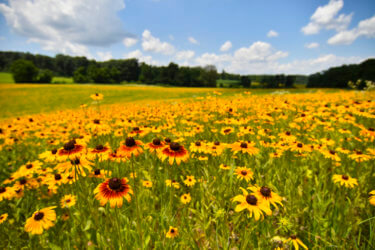 A wildflower is a flower that grows without any help from people, they grow naturally in their environment. People may grow wildflowers in their garden, but most wildflowers are native plants and grow in woods, meadows, wetlands – anywhere they adapted to grow.
A wildflower is a flower that grows without any help from people, they grow naturally in their environment. People may grow wildflowers in their garden, but most wildflowers are native plants and grow in woods, meadows, wetlands – anywhere they adapted to grow.
Native plants are essential in nature, because they provide food and habitat for animals of all kinds, including humans. They filter the air and reduce soil erosion. Because native plants fill a niche, or specific function, within their ecosystem, they seldom grow beyond the needs and capacities of that ecosystem.
nature id.
This is one of the first native wildflowers you will see blooming in our woods. It is named for the color of it’s sap.
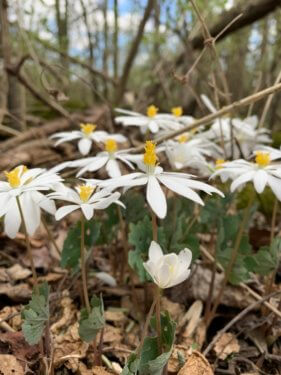
Photo of Green Hills Preserve by Emma Schad
Answer: This bloodroot was found at Green Hills Preserve. Bloodroot is one of many plants whose seeds are spread by ants. The seeds have a fleshy organ called an elaiosome that attracts ants, where the ants will take the seeds to their nest, where they eat the elaiosomes, and put the seeds in their nest debris. The seed then is protected until they germinate. They also benefit from growing in a medium made richer by the ant nest debris.
play.
Grow your own wildflower garden:
You can find native plants and seed mixes online or at your local garden center. Natives are a wonderful way to go. You don’t have to grow a lot to make a BIG difference. You will be kind to the environment, and what a wonderful way to spend an afternoon watching butterflies flit around your yard.
The Department of Conservation and Natural Resources has a great list of PA native plant nurseries and online stores.
If you go with seeds and are not worried about getting dirty, make seed bombs. Click here for instructions.
learn.
Plants have five main parts: leaves, stem, flowers, fruit, and roots. Flowers are not only pretty, but they help attract insects and other animals to get pollinated so they can produce seeds to make more flowers. Flowers have different parts too! If you get really close you will see different parts, each with a special job.
play.
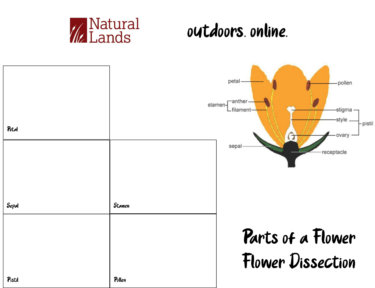 Today we’re going to dissect a flower. Dissecting means to take something apart. It is a great way to learn about plants. Choose a flower for your experiment. Remember to ask permission first.
Today we’re going to dissect a flower. Dissecting means to take something apart. It is a great way to learn about plants. Choose a flower for your experiment. Remember to ask permission first.
If you can, find flower that’s big, not teeny tiny like a violet. Azaleas, magnolias, and daffodils work well, as well as alstroemeria or tulips which are common flowers you can get from a grocery store. Print this sheet (parts of a flower) and follow the directions at this link.
nature id:
This flower is named after an animal that looks like the leaves.
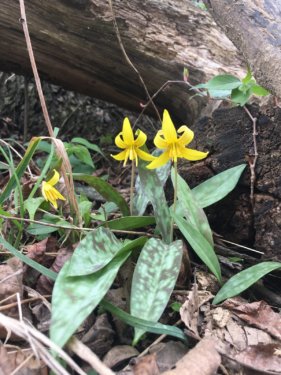
Answer: This trout lily is from Bryn Coed Preserve. It is one of our most common spring ephemeral wildflowers, and it is found in sizable colonies. Spring ephemerals are flowers that capture the early spring sunlight before the leaves of trees start to grow and shade out the flowers. The common name “trout lily” refers to the appearance of its gray-green leaves mottled with brown or gray, which allegedly resemble the coloring of brook trout.
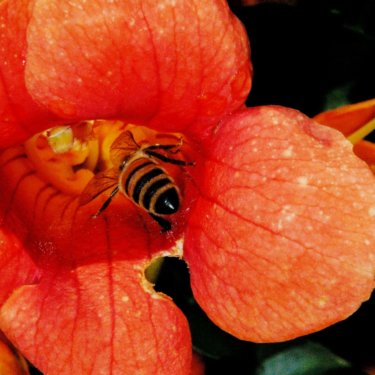 Flowers have both male and female parts. Pollination is achieved when the pollen from the male part, the stamen, is transferred to the female part, the stigma. This is called fertilization and it’s what helps the flower make seeds. This can happen between the male and female parts of one flower (self-pollination) or between separate flowers of the same species (cross-pollination). Flowers can’t do it themselves. What in the natural world can help move the pollen? Animals, wind, or water! We call the animals that visit flowers pollinators.
Flowers have both male and female parts. Pollination is achieved when the pollen from the male part, the stamen, is transferred to the female part, the stigma. This is called fertilization and it’s what helps the flower make seeds. This can happen between the male and female parts of one flower (self-pollination) or between separate flowers of the same species (cross-pollination). Flowers can’t do it themselves. What in the natural world can help move the pollen? Animals, wind, or water! We call the animals that visit flowers pollinators.
learn.
Why do pollinators (e.g. birds, insects, bats) visit flowers? Most feed on the nectar of a flower. Since the nectar is usually located deep in the middle of a flower pollinators have to brush against the anthers, and then the stigma to get to the nectar. When this happens, this helps carry pollen from one part of the flower to another. Some pollinators, like bees, need pollen in addition to nectar. Some pollinating insects (some flies) are attracted to flowers by scent but gain no reward when they visit. The insects try to leave quickly but the flowers may have traps to slow the insects down.
craft.
Before you go outside, make a bee out of yellow pipe cleaners, black felt (or dark colored felt), and something long like a pencil.
Wrap the dark felt around the end of the pencil and hold on. Take the pipe cleaner and wrap it around the pipe cleaner to secure. Voila… a bee!
nature id:
One of the first flowers that bloom in woodlands.
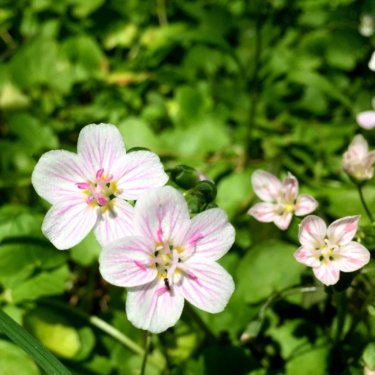
Answer: This sweet little spring beauty was found at Hildacy Preserve. Spring beauties are also a spring ephemeral and a harbinger of spring. The flowers open up on warm sunny days, and close during cloudy weather or at night. They can survive more environmental degradation than most spring-blooming woodland species, including occasional grazing by deer and partial clearing of trees. This is one reason why it is still common.
play.
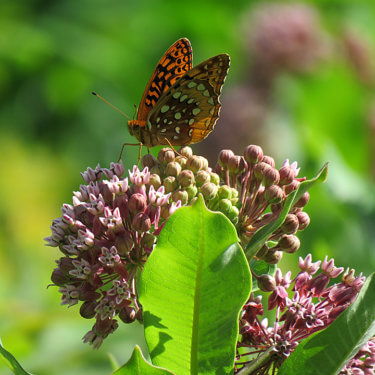
Great Spangled Butterfly
Go outside and look for some pollinators, butterflies, bees, and flies. Watch and see how they have pollen all over them. Honey bees and other bees get covered in pollen. Sometimes so much they have a hard time flying.
Take the bee that you created and visit some flowers. When you remove the ‘bee’ you may see some pollen stuck on the felt. Go visit more flowers… now you are pollinating.
learn.
Wildflower seeds travel so they can find just the right spot to start growing. They can hitchhike on animal fur, get blown by the wind, travel in bird tummies, float down a river, or a squirrel might hide a nut. Can you think of ways a seed might travel?
watch.
play.
Do a seed experiment. Go outside and look for seeds in flowers and from trees. You might find some seeds in your refrigerator like peppers, avocado, or even apples.
Try to make that seed fly.
nature id:
Native Americans and early Euro-American settlers used this plant as a spice.
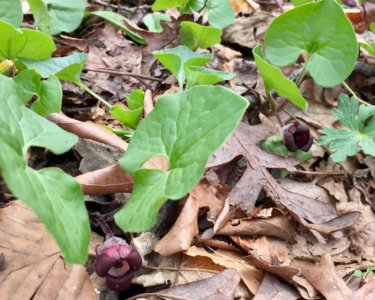
Answer: This wild ginger was found at Crow’s Nest Preserve. This flower evolved to attract small flies that emerge from the dirt in the spring looking for a thawing carcass of an animal. By lying next to the ground this flower is readily found by the flies. The flies enter the flower to escape the cold winds of early spring and to feast upon the flowers pollen. Some of the pollen attaches to their bodies and goes with them when they visit the next flower.
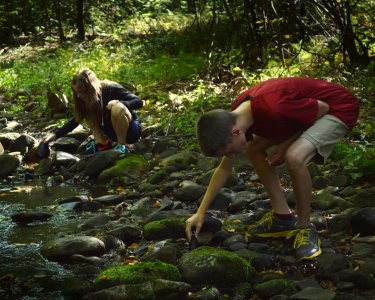 Today we’re going to become citizen scientists.
Today we’re going to become citizen scientists.
learn.
Project Budburst is a great online project that studies the phenology of plants. Phenology is the study of the timing of the biological events in plants and animals such as flowering, leafing, hibernation, reproduction, and migration. Scientists who study phenology are interested in the timing of such biological events in relation to changes in season and climate. By participating in this, and use everything you learned earlier, you could be a botanist in no time.
Create an account and start noting when plants are blooming, producing seeds, dropping leaves, and more.
play.
There are so many flower crafts. We created a flower fun section on our Outdoors Online Pinterest page for more activities you can do. Most activities are things you can do at home with minimal supplies or activities you can do right in your backyard or a walk around your block.
nature id.
The name of this plant refers to the flower parts occurring in three.
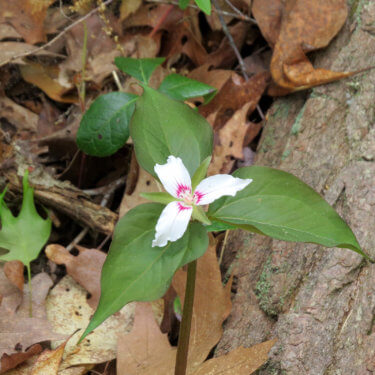
Answer: This painted trillium was found at Bear Creek Preserve. Like other trillium, this species is most likely impacted by invasive species and deer who find it to be a tasty snack. When the forests and fields are turned into houses and parking lots it can make it harder for plants like this to find a place to grow. Thank goodness for the 3,565 acres of Bear Creek Preserve that give these beautiful wildflowers a place to bloom.